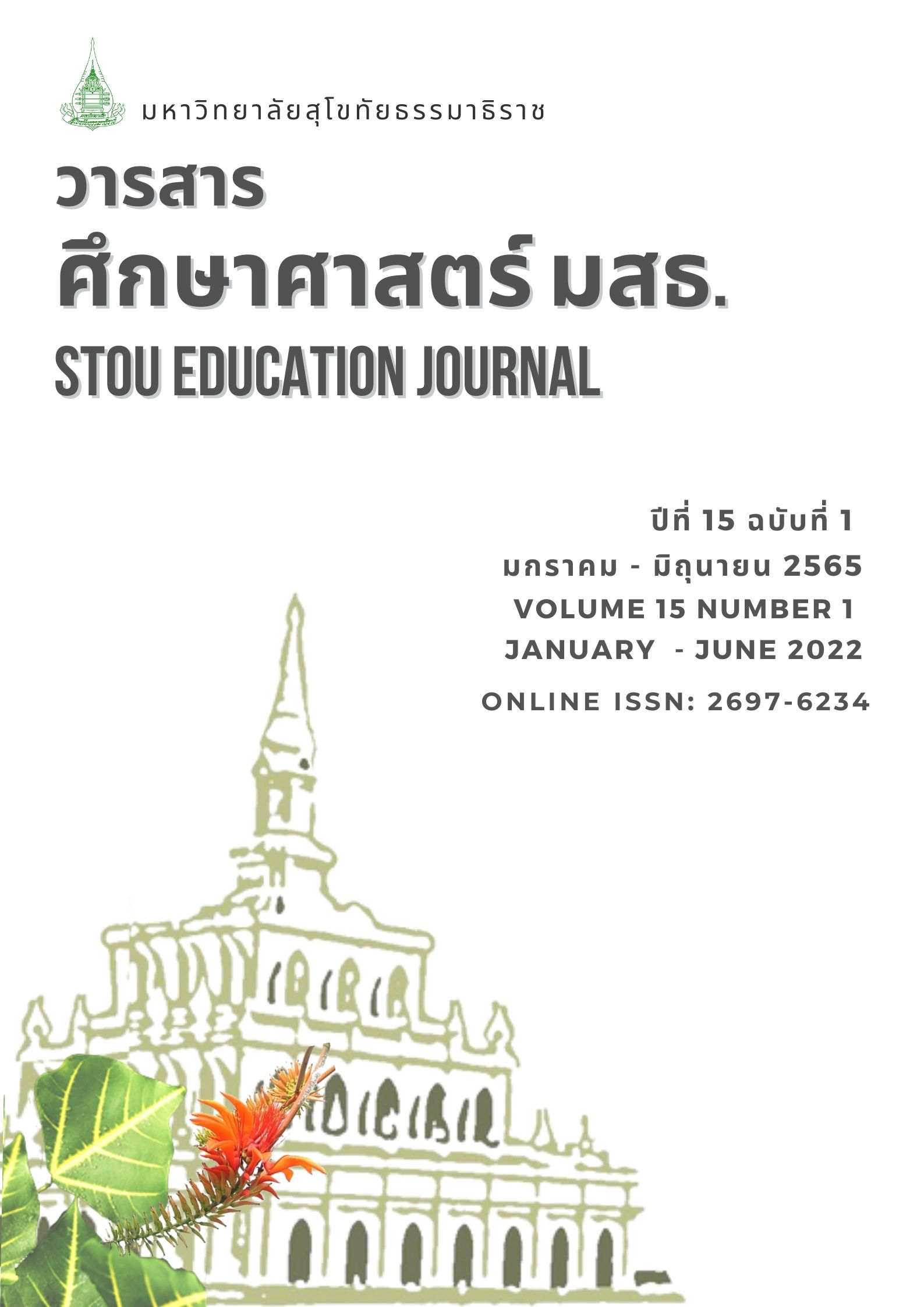The Effects of Play Experience Provision Based on Design Playworld Model with Community of Inquiry on Problem Solving Thinking of Young Children
Main Article Content
Abstract
The purpose of this research was to study the effects of play experience provision based on Design Playworld Model with Community of Inquiry on problem solving thinking of young children. The sample was 9 kindergarteners age 5-6 years old obtained by purposive sampling. The research instruments included 1) play experience provision plans based on Design Playworld Model with Community of Inquiry, 2) a performance-based assessment form of problem solving thinking, and 3) a behavior observational form of problem solving thinking. The quantitative data were analyzed by using the mean and standard deviation, and the qualitative data was analyzed by conducting a content analysis. The results showed that young children who obtained learning provision had a higher assessment of problem-solving thinking than before. Children identified problems appropriately by themselves, understood the cause of the problem, found, decided and reasoned solutions according to the situation. After that, they tried to put their ideas into practice until it succeeds and be able to evaluated the results properly.
Article Details
References
เกรียงศักดิ์ เจริญวงศ์ศักดิ์. (2562). ลายแทงนักคิด (พิมพ์ครั้งที่ 12). ซัคเซส พับลิชชิ่ง. กลุ่มสนับสนุนวิชาการและการวิจัย สำนักส่งเสริมสุขภาพ กรมอนามัย. (2561, พฤศจิกายน). รายงานการศึกษาปัจจัยที่มีผลต่อพัฒนาการเด็กปฐมวัยไทย ครั้งที่ 6 พ.ศ. 2560. http://203.157.71.139/group_sr/allfile/1580280672.pdf
ขวัญศิริ พัฒนมณี. (2559). การจัดกิจกรรมเล่านิทานไม่จบเรื่องเพื่อส่งเสริมการคิดแก้ปัญหาของเด็กปฐมวัย. [การศึกษาค้นคว้าอิสระศึกษาศาสตรมหาบัณฑิต ไม่ได้ตีพิมพ์]. มหาวิทยาลัยเกษตรศาสตร์.
คณะอนุกรรมการตรวจสอบและประเมินผลภาคราชการ กลุ่มกระทรวง คณะที่ 2. (2562, พฤศจิกายน). รายงานการพัฒนาเด็กปฐมวัย. https://www.nesdc.go.th/ewt_w3c/ewt_dl_link.php?nid=10104
ทิศนา แขมมณี. (2562). ศาสตร์การสอน (พิมพ์ครั้งที่ 23). สำนักพิมพ์จุฬาลงกรณ์มหาวิทยาลัย.
นภเนตร ธรรมบวร. (2549). การพัฒนากระบวนการคิดในเด็กปฐมวัย (พิมพ์ครั้งที่ 4). สำนักพิมพ์แห่งจุฬาลงกรณ์มหาวิทยาลัย.
ประเสริฐ ผลิตผลการพิมพ์. (2563). 100 บทเรียนเลี้ยงลูกเจนอัลฟ่า. อมรินทร์คิดส์ อมรินทร์พริ้นติ้ง แอนด์ พับลิชชิ่ง.
ปัทมศิริ ธีรานุรักษ์. (2544). ผลของการใช้กระบวนการเรียนการสอนตามแนวการสอนแบบชุมชนแห่งการสืบสอบเชิงปรัชญาที่มีต่อทักษะการคิดของเด็กชั้นประถม ศึกษาปีที่ 1. [วิทยานิพนธ์ครุศาสตรดุษฎีบัณฑิต ไม่ได้ตีพิมพ์]. จุฬาลงกรณ์มหาวิทยาลัย.
ปัทมาวดี เล่ห์มงคล. (2560). หน่วยที่ 6 พัฒนาการและการเรียนรู้ทางการคิดของเด็กปฐมวัย. ใน เอกสารการสอนชุดวิชา พัฒนาการและการเรียนรู้ของเด็กปฐมวัย หน่วยที่ 1-7 (พิมพ์ครั้งที่ 7, น.1-34). นนทบุรี: สาขาวิชาศึกษาศาสตร์ มหาวิทยาลัยสุโขทัยธรรมาธิราช.
ไพฑูรย์ สินลารัตน์, สุมน อมรวิวัฒน์, ทิศนา แขมมณี, นวลจิตต์ เชาวกีรติพงศ์, ศรินธร วิทยะสิรินันท์, สิริภักตร์ ศิริโท, ทวีศักดิ์ จินดานุรักษ์, ศรเนตร อารีโสภณ พิเชฐ, อุทัย ดุลยเกษม, พิมพ์พันธ์ เดชะคุปต์, พรรณี เกษกมล, และ พิมพันธ์ เดชะคุปต์. (2558). ศาสตร์การคิด. DPU Cool Print มหาวิทยาลัยธุรกิจบัณฑิตย์.
วอลเลซ, บี. (2559). การจัดการเรียนรู้เพื่อพัฒนาทักษะการคิด ระดับอนุบาล-ประถมต้น [Teaching thinking skills across the early years]. นานมีบุ๊คส์.
วิจารณ์ พานิช. (2561). พลังแห่งวัยเยาว์. แปลน พริ้นท์ติ้ง. สำนักงานคณะกรรมการการศึกษาขั้นพื้นฐาน กระทรวงศึกษาธิการ. (2562). รายงานผลการประเมินพัฒนาการนักเรียนที่จบหลักสูตรการศึกษาปฐมวัย พุทธศักราช 2560 ปีการศึกษา 2561. โรงพิมพ์อักษรไทย (น.ส.พ. ฟ้าเมืองไทย).
หทัยภัทร ไกรวรรณ. (2559). การจัดประสบการณ์การเรียนรู้แบบสตีมศึกษาที่มีต่อความสามารถในการแก้ปัญหาอย่างสร้างสรรค์ของเด็กปฐมวัย. [วิทยานิพนธ์ ศึกษามหาบัณฑิต ไม่ได้ตีพิมพ์]. มหาวิทยาลัยเกษตรศาสตร์.
อรพรรณ พรสีมา. (2543). การคิด. สถาบันพัฒนาทักษะการคิด.
Baumer, S., Ferholt, B., & Lecusay, R. (2005). Promoting narrative competence through adult–child joint pretense: Lessons from the Scandinavian educational practice of playworld. Cognitive Development, 204, 576-590. https://doi.org/10.1016/j.cogdev.2005.08.003
Berk, S. (2016). Designing for the future of education requires design education. Art Education, 69(6), 16-20. https://doi.org/10.1080/00043125.2016.1224844
Bland, L. M., & Gareis, C. R. (2018). Performance assessments: A review of definitions, quality characteristics, and outcomes associated with their use in K-12 schools. Teacher Educators' Journal, 11, 52-69. https://files.eric.ed.gov/fulltext/EJ1174728.pdf
Britz, J. (1993). Problem solving in early childhood classrooms. ERIC digest. https://files.eric.ed.gov/fulltext/ED355040.pdf
Coorey, J., & Rinnert, G. C. (2019). Design thinking for preschoolers: encouraging empathy through play. Paper presented at the DESIGN REVOLUTIONS: International Association of Societies of Design Research Conference 2019, Manchester School of Art, Manchester Metropolitan University. https://iasdr2019.org/uploads/files/Proceedings/le-f-1157-Coo-J.pdf
Diamond, L. L. (2017). Problem solving in the early years. Intervention in School and Clinic, 53(4), 220-223. https://doi.org/10.1177/1053451217712957
Ferholt, B. (2009). The development of cognition, emotion, imagination and creativity as made visible through adult-child joint play: Perezhivanie through Playworlds [Unpublished doctoral dissertation]. https://escholarship.org/uc/item/0w22g2jd
Ferholt, B., Nilsson, M., Jansson, A., & Alnervik, K. (2015). Creativity in education: Play and exploratory learning. In T. Hansson (Ed.), Contemporary approaches to activity theory: Interdisciplinary perspectives on human behavior (pp. 264-284). IGI Global.
Fettig, A., Schultz, T. R., & Ostrosky, M. M. (2016). Storybooks and beyond: Teaching problem solving skills in early childhood classrooms. Young Exceptional Children, 19(3), 18-31. https://doi.org/10.1177/1096250615576803
Fleer, M. (2019). Conceptual Playworlds as a pedagogical intervention: Supporting the learning and development of the preschool child in playbased setting. Revista Obutchénie, 3(3), 1-22. https://doi.org/10.14393/OBv3n3.a2019-51704
Fleer, M. (2019, March 13). Five steps for early childhood educators to create a Conceptual PlayWorld and encourage a love of STEM. https://www.monash.edu/education/teachspace/articles/five-steps-for-early-childhood-educators-to-create-a-conceptual-playworld-and-encourage-a-love-of-stem
Gosen, M. N., Berenst, J., & de Glopper, K. (2015). Problem-solving during shared reading at kindergarten. Classroom Discourse, 6(3), 175-197. https://doi.org/10.1080/19463014.2014.991339
IDEO. (2012). Design thinking for educators. https://www.ideo.com/post/design-thinking-for-educators
Lindqvist, G. (1995). The aesthetics of play a didactic study of play and culture in preschools. (Doctoral dissertation). https://files.eric.ed.gov/fulltext/ED396824.pdf
Nitko, A. J., & Brookhart, S. M. (2010). Educational assessment of students (6 ed.). Pearson.
Piaget, J., & Inhelder, B. (2019). The psychology of the child (2 ed.). Basic Books.
Poole, C., Miller, S. A., & Church, E. B. (2004). Development: Ages & stages-How children learn to problem-solve. Early Childhood Today, 19(2), 29-34.
Solomon, T. (2020). Playworlds. https://www.playcentre.org.nz/virtual-village/play-insights-nature-play/
Splitter, L. J., & Sharp, A. M. (1995). Teaching for better thinking. Australian Council for Educational.
Zurek, A., Torquati, J., & Acar, I. (2014). Scaffolding as a tool for environmental education in early childhood. International Journal of Early Childhood Environmental Education, 2(1), 27-57. https://cdn.naaee.org/sites/default/files/ijecee_21_winter_2014_issue_0.pdf


